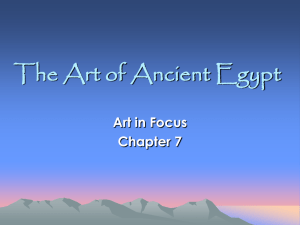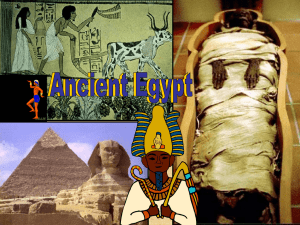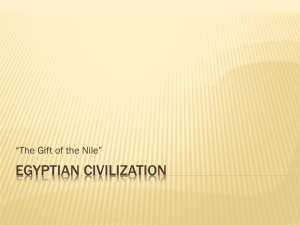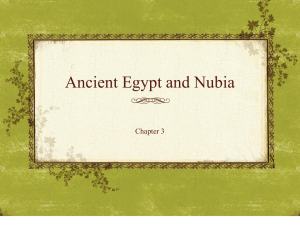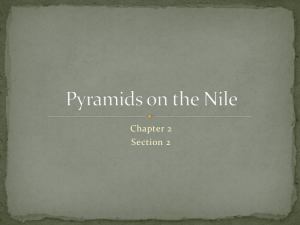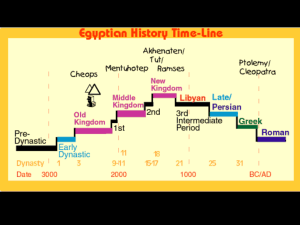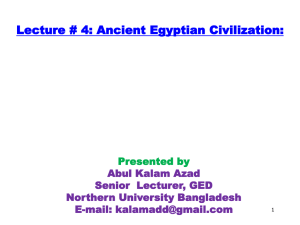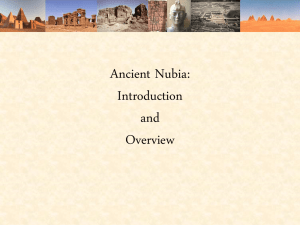Ancient Nile Kingdoms
advertisement
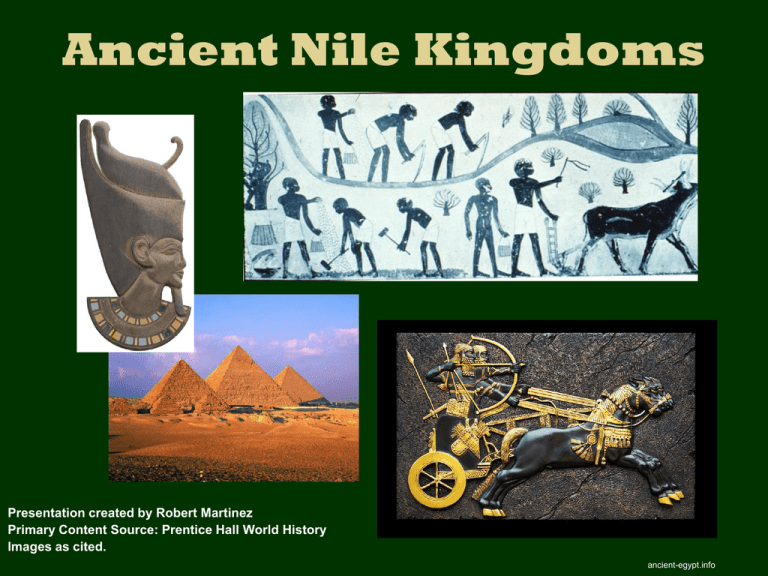
Ancient Nile Kingdoms Presentation created by Robert Martinez Primary Content Source: Prentice Hall World History Images as cited. ancient-egypt.info In ancient times, farming villages dotted the narrow band of land watered by the Nile. Beyond the rich, irrigated “Black Land,” generally no more than 10 miles wide, lay the “Red Land,” a sun-baked desert that stretches across North Africa. goldhistorian.blogspot.com prntrkmt.org Farmers took advantage of the fertile soil of the Nile Valley to grow wheat and flax, a plant whose fibers were used for clothing. visav.phys.uvic.ca The Nile rises in the highlands of Ethiopia and the lakes of central Africa. Every spring, rains in this interior region send water racing down streams that feed the Nile River. In ancient times, Egyptians eagerly awaited the annual flood. It soaked the land with life-giving water and deposited a layer of rich silt. cruises.about.com People had to cooperate to control the Nile floods. They built dikes, reservoirs, and irrigation ditches to channel the rising river and store water for the dry season. egy-king.blogspot.com Ancient Egypt had two distinct regions. Upper Egypt in the south and Lower Egypt in the north. Upper Egypt stretched from the first cataract, or waterfall, of the Nile northward to within 100 miles of the Mediterranean. thesoftmanias.blogspot.com Lower Egypt covered the delta region where the Nile empties into the Mediterranean. A delta is a triangular area of marshland formed by deposits of silt at the mouth of some rivers. franklin.ma.us About 3100 B.C.E., Menes, the king of Upper Egypt, united the two regions. He and his successors used the Nile as a highway linking north and south. They could send officials or armies to towns along the river. The Nile thus helped make Egypt the world’s first unified state. cardsmall.wordpress.com The river also served as a trade route. Egyptian merchants traveled up and down the Nile in sailboats and barges, exchanging the products of Africa, the Middle East, and the Mediterranean world. britannica.com The history of ancient Egypt is divided into three main periods, the Old Kingdom, the Middle Kingdom, and the New Kingdom. Although power passed from one dynasty to another, the land generally remained united. tigtail.org During the Old Kingdom, Egyptian rulers called pharaohs organized a strong, centralized state. Pharaohs claimed divine support for their rule. Egyptians believed the pharaoh was a god. The pharaoh thus had absolute power, owning, and ruling all the land in the kingdom. pharaohsandpyramids.blogspot.com Pharaohs of the Old Kingdom took pride in preserving justice and order. A pharaoh depended on a vizier, or chief minister, to supervise the business of government. Under the vizier, various departments looked after such matters as tax collection, farming, and the irrigation system. Thousands of scribes carried out the vizier’s instructions. love-egypt.com During the Old Kingdom, the Egyptians built the majestic pyramids that still stand at Giza. The pyramids were tombs for eternity. Because Egyptians believed in an afterlife, they preserved the bodies of their dead rulers and provided them with everything they would need in their new lives. fanpop.com bbc.co.uk To complete the pyramids, workers hauled and lifted millions of limestone blocks, some weighing two tons or more. The builders had no iron tools or wheeled vehicles. Workers quarried the stones by hand, pulled them on sleds to the site, and hoisted them up earthen ramps. Building a pyramid took so long that often a pharaoh would begin to build his tomb as soon as he inherited the throne. historyonthenet.com The pyramids suggest the strength of ancient Egyptian civilization. These costly projects required enormous planning and organization. Thousands of farmers, who had to be fed each day, worked on the pyramids when not planting or harvesting crops. bbc.co.u k Power struggles, crop failures, and the cost of the pyramids contributed to the collapse of the Old Kingdom. After more than a century of disunity, new pharaohs reunited the land, ushering in the Middle Kingdom. earlyworldhistory.blogspot.com The Middle Kingdom was a turbulent period. The Nile did not rise as regularly as it had. Corruption and rebellions were common. Still, strong rulers did organize a large drainage project, creating vast new stretches of farmable land. historyandcivilization Egyptian armies occupied part of Nubia, the gold-rich land to the south. Traders also had greater contacts with the peoples of the Middle East and the Mediterranean island of Crete. pharaonic-egy.blogspot Catastrophe struck about 1700 B.C.E. when foreign invaders, the Hyksos, occupied the delta region. They awed the Egyptians with their horse-drawn chariots. In time, the Egyptians mastered this new military technology. flickr.com The Hyksos, in turn, were impressed by Egyptian civilization. They soon adopted Egyptian customs, beliefs, and even names. Finally, after more than 100 years, new Egyptian leaders arose. They drove out the Hyksos and set up the New Kingdom. en.wikipedia.org During the New Kingdom, powerful and ambitious pharaohs created a large empire. At its height, the Egyptian empire reached the Euphrates River. This age of conquest brought Egypt into greater contact with southwestern Asia as well as other parts of Africa. media1.mweb.co.za gnosis.us.com One monarch of the New Kingdom, Hatshepsut was a woman who exercised all the rights of a pharaoh. From 1503 B.C.E. to 1482 B.C.E., she encouraged trade with eastern Mediterranean lands and along the Red Sea coast of Africa. eyelid.co.uk The most powerful pharaoh of the New Kingdom was Ramses II. Between 1290 B.C.E. and 1224 B.C.E., Ramses pushed Egyptian rule northward as far as Syria. On temples and monuments, he boasted of his conquests, though his greatest reported victory may not actually have taken place. s9.com In a battle against the Hittites of Asia Minor, only the desperate bravery of Ramses himself prevented a crushing defeat. Back home, Ramses had inscriptions carved on a monument that made the near defeat sound like a stunning victory. touregypt.net After years of fighting, the Egyptians and Hittites signed a peace treaty, the first such document known to have survived in history. It declared that Egypt and the Hittites “shall be at peace and in brotherhood forever.” en.wikipedia.org After Ramses II, Egyptian power slowly declined. Invaders, such as the Assyrians and Persians, conquered the Nile region. Later, Greek and Roman armies came from the north. Each new conqueror was eager to add the fertile Nile Valley to a growing empire. fravahr.org The Nile kingdom of Nubia (known also as Kush) developed to the south of Egypt. For centuries, Egyptians traded or fought with their southern neighbor. From Nubia, they acquired ivory, cattle, and slaves. During the new kingdom, Egypt conquered Nubia. en.wikipedia.org Ramses II used gold from Nubia to pay charioteers in his army. Nubians served in Egyptian armies and left their mark on Egyptian culture. Much Egyptian art of this period shows Nubian soldiers, musicians, or prisoners. abovetopsecret.com As Egypt declined, Nubia regained its independence. In 750 B.C.E., Nubian kings marched north, adding Egypt to their own lands. For 100 years, the Nubian empire stretched from what is today Sudan to the Mediterranean. blackvikingen.blogspot.com The Nubians saw themselves not as foreign conquerors but as restorers of Egyptian glory. They ruled Egypt like earlier pharaohs, respecting ancient Egyptian traditions. jandyongenesis.blogspot.com About 650 B.C.E., Assyrians, armed with iron weapons, descended on Egypt. They pushed the Nubians back into their original homeland, where Nubian monarchs ruled for 1,000 years more. ninevehmarket.com

